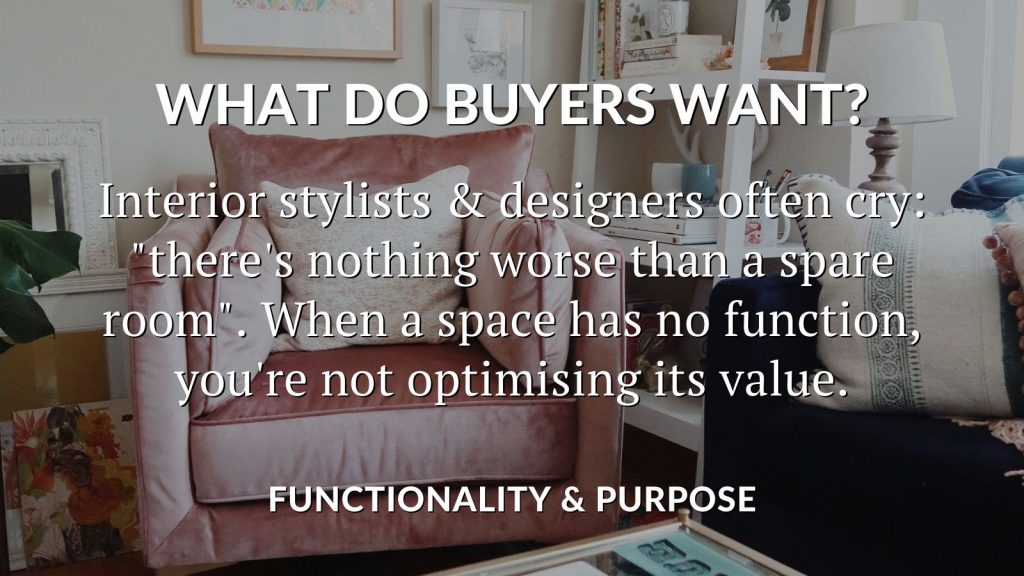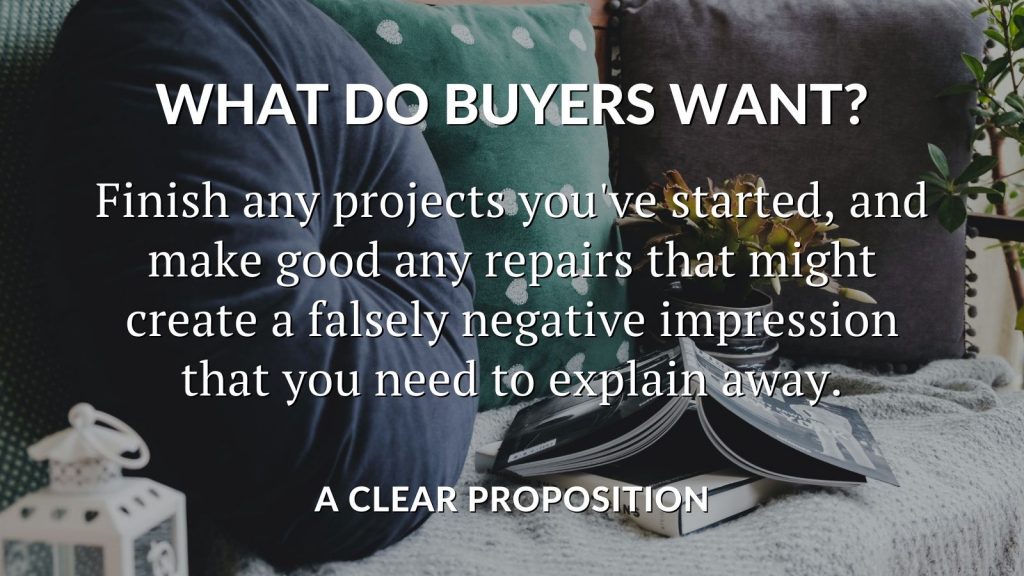WHAT DO BUYERS WANT? FIVE FUNDAMENTAL FACTORS THAT TURN VIEWINGS INTO SALES

We’ve all had that sense of all-consuming joy when finding the home of our dreams, and what a feeling it is! Excitement, anticipation and nerves all rolled into a single moment, and much of it unquantifiable.
There’s a lot that goes into a decision to buy, from emotional, financial and intellectual reasons to a healthy dose of gut-feeling. And while practical considerations like size, price and fittings certainly play their part, they all take a back seat to the most influential factor of all: how a home feels. Is it ‘the one’?
The feeling goes way beyond the phrase ‘location location location’ because people live in all sorts of places for all kinds of reasons, many of them non-negotiable. A school’s catchment area; a particular station for a quick commute; moving closer to a family member; being in a specific street or neighbourhood: these create the framework for many property searches.
But as soon as viewings begin, it’s the physical experience of each home that comes into play. Much of that includes condition and character, but there are other, less obvious ways of helping a buyer to say yes to the only question that really matters: “Could I be happy here?”
It’s never too early to talk about how to get your home ready to sell, so do get in touch if you’re not yet sure where to start. Call us for a chat on 042 933 2482 or email us at info@lavelles.ie – let us know what you’re thinking, and we’ll help in any way we can.
Meanwhile, let’s look at how you can help a buyer to see your current home as their next one.
VISIBLE FLOOR SPACE
When it comes to pure bang for your buck, what really counts is visible floor space. A plan shows the technical details, but it doesn’t tell the whole story. It’s only when standing inside your home that someone will get the sense of how big – or small – it feels in person.

To optimise your photos and viewings, it’s essential to factor in movement and sight-lines. When we bring someone to see your home, there’ll be at least two people, possibly three, and maybe even a whole family walking around at the same time, so if there are obstacles to seeing an entire room, you’ll be giving the sense of a lack of space.
If a buyer needs to shuffle around furniture or there’s nowhere to move inside a room, there’s probably too much in it to give you the best chance of selling. Try changing the position of a couch or coffee table, or removing an armchair or footstool: small changes like these can dramatically improve your photographs and transform reactions on viewings.
Aside from furniture, think about what else is in the room. Do you have piles of magazines, books or vinyl on the floor? Their presence can create a sense of warmth and comfort, but they should either go onto shelves – or put away out of sight – for the time your home is on the market.
There’s a fine line between a room being emptied of clutter and a room feeling cold and bare, and we’ll help you strike the perfect balance.
FUNCTIONALITY & PURPOSE
Interior stylists and designers often cry: “there’s nothing worse than a spare room.” They’re right, and when a room doesn’t have a function, its value is reduced. Not every buyer can visualise a desk, bookshelves, easy chair and elegantly-painted walls.

You’ve probably seen pictures of show homes or maybe even visited some. House-builders know that standing people inside a series of empty rooms – or among building materials – simply doesn’t portray the lifestyle available. The same is true for lived-in homes.
Spare rooms can develop over time and you can get so used to them that you no longer notice. Perhaps you’ve stopped using a bedroom since a family member moved out, or maybe you never occupied one as intended. It’s completely normal, but once a room starts collecting boxes or junk, its purpose and functionality become unclear.
Furnishings and accessories enhance a room and highlight its features. Think of a reading chair in a bay window, a hearth rug in front of a fireplace, or even books on shelves: you won’t be leaving any of them behind, but they show purpose, function and possibility.
Find another home for the boxes, and if you have an empty room, look at relocating furnishings or accessories from elsewhere. Perhaps you can create a study, reading room or workspace to add extra purpose and maximise your home’s appeal.
POTENTIAL (SOMETIMES)
The P-word can be highly potent, and we often meet buyers who are willing – and even hoping – to improve, extend or upgrade a home. Potential can be a true enabler of interest, widening your market beyond the limits of your home’s current accommodation or offer. But that potential needs to be qualified.

Simply declaring that an extension could provide another two bedrooms and an extra bathroom isn’t necessarily enough: you need to demonstrate how possible and probable it is. By making it simple for a viewer to visualise themselves in that new space and how it could work for them, you’ll add credibility, excitement and value.
Sometimes, it’s easy. A similar extension or remodelling that your home could take might have been completed nearby, with photos that show the finished result.
Otherwise, and if your home has the potential for a unique or particular expansion, get some plans drawn up by an architect. Going one step further still, gaining full planning consent to carry out the works will give a buyer complete certainty and help you achieve a higher price.
A CLEAR PROPOSITION
Imagine going to view a total wreck; somewhere that’s not been updated for decades and where everything clearly needs doing. Now think of a home where everything is perfect and where tons of love has gone into creating a wonderful, beautiful place to live.

These two extremes of condition and presentation share one common quality: clarity. You have the sense that you know exactly what you’re getting and what you’re taking on: it’s either a real fixer-upper or a ready-made home.
In the middle are the halfway-houses that, in some way, throw in doubts, and often from unfinished projects. Maybe you’ve removed all the wallpaper from a room and haven’t yet redecorated, leaving the old, unsightly plasterwork exposed. Perhaps you replaced your kitchen or bathroom fittings but never completed the tiling, leaving your renovations – and financial investment – looking less attractive and even less valuable.
This lack of clarity isn’t limited to improvements; it can also affect maintenance and repairs. You could have fixed a leak, but leaving a historic water stain on a ceiling or wall can raise questions over potential plumbing, roof or damp problems. Or that peeling paint on your window frames can leave them looking in need of replacement, rather than simply a sanding and fresh coat.
Relatively small issues like these can negatively affect a buyer’s thoughts about your home. So finish what you’ve started, and make good anything that’s creating a falsely negative impression.
FUTURE SALEABILITY
People like to feel comfortable that the property they’re thinking of buying is somewhere they’ll be able to sell. Not every home is a forever home, and a buyer could be looking at yours as a stepping stone to their future goals. In short, nobody wants to get stuck.

Are there any unsaleable properties? Not really, but some can look unpopular, and that’s often down to how long they’ve been on the market. With so much information readily available on the national portals, from when a property first came on the market to all its subsequent price reductions, a list of evidence soon begins to build.
Perception is hugely important. Multiple price reductions don’t always look like a bargain to buyers; more often, they suggest a property that nobody wants and can lose the perfect new owner before they even view. We don’t always get to find out why someone chooses not to call, but we do know that when homes sit on the market, they don’t become more attractive.
If you’re ever tempted to try a higher price when you first put your home up for sale, don’t let it drag on: you’ll know within a couple of weeks whether it was the right decision. If you get no interest at all – or if everyone who views says your home is too expensive – you’ll know what you need to do.
And if your home has been on the market for some time, you could well be better off with an altogether new strategy. As well as providing a fresh perspective and energy, switching agents will give you an automatic reset on the property portals, restoring that valuable “new listing” status for an invigorating restart.
In summary
Much of someone’s decision to buy is outside your control, but you can have a considerable influence through the viewing experience you create. By removing potential obstacles and objections and replacing them with clarity and credibility, you make it easy for a buyer to see your home as the most exciting and enticing choice.
Would you like to maximise the saleability and attraction of your home? If you have a property to sell in County Louth, we’d love to show you how we can help. Call for a chat on 042 933 2482 or email us at info@lavelles.ie– there’s a lot to do when moving home, so let’s get talking soon.